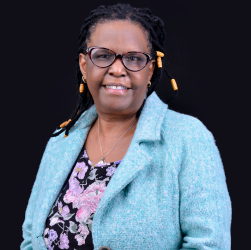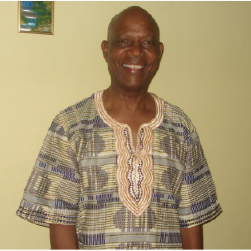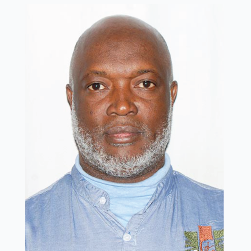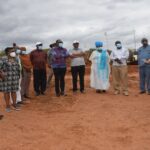Wanjala Mshila Sio
Wanjala Sio Profile
NAME Wanjala Mshila Sio
NATIONALITY Kenyan
MARITAL STATUS Married Three children // Two grandchildren
ADDRESS: 63892 – 00619 – Muthaiga – Nairobi
EMAIL: wanjala@pie-ies.com
MOBILE TEL: +254 703 11 90 84 – 0707 999 740
FORMAL EDUCATION & PROFESSION
1972 – 1975 Diploma in Education – Kenyatta University
1975 – 1991 TEACHER
1975 – 1978 Our Lady of Mercy – NAIROBI
1979 – 1982 Pangani Girls – NAIROBI
1983 – 1991 Loreto Convent – Msongari – Nairobi
BUSINESS – ENTREPRENEURSHIP – MATTERS ENVIRONMENT
1991 T0 DATE
PIE INTERNATIONAL EDUCATION SERVICES
Founder & Executive Director,
Consulting for Sommet Education Group (Switzerland) in Eastern & Western Africa & Publishing
2005 TO DATE
INTERNATIONA HOTEL & TOURISM INSTITUTE – Nairobi
CO-FOUNDER and Director
2015 TO DATE
Tsavo Heritage Foundation
Co-Founder and Deputy President
(The Rehabilitation of the Tsavo Eco-system holistically)
2018 –
AWARDS – Environment Restoration Champion of Taita/Taveta County By TaitaTaveta Professional & Business Women
2009 – TO DATE
AUTHOUR
- The Golden Concept of The Law of Success -Program on Character &Values Development.
- The Environment Restoration Journal – The Creation of Micro-Climates in Learning Institutions
- Both books have been vetted and approved by Kenya Institute of Curriculum Development – work in progress to get them into Schools & Colleges
ADVOCATING & WORKING TOWARDS THE HOLISTIC RESTORATION OF:
- The Tsavo Eco-system &Dispersal Areas – by Restoration of The Water Towers & Wetlands, Rangelands & Blue-scapes History, Culture & Livelihoods.
- Education for Life skills
My Motivation.
Tsavo is a Heritage. A Heritage to Behold; To be Treasured and Upheld.
The Efforts to rehabilitate this degraded God’s Piece of Earth is very personal to me! I was excited when I ‘discovered’ that “It is possible to rehabilitate a large scale damaged eco-system” –a John D. Liu Documentary – Green Gold – 2012
I was born and raised in the Tsavo Rangelands almost seven decades ago. My home was, and still is in this now degraded Medaikwane (where two rivers meet) River Basin in Shelemba near Voi.
I can say the following without fear of contradiction.
This Medaikwane River Basin created a land so fertile that is became a Paradise; a Garden of Eden; for humans, animals, both domestic and wild, birds, snakes and plants.
Birds migrated along the healthy riparian zones of both the small tributary (Mwafure) and the main Voi
River (we just called it Moda ughu Mbaa- The Big River). The Voi River riparian zones, upstream, were held together mostly by sugarcane. Sugarcane was so plentiful that as a little girl, I knew by name the different types. There is even a Taita saying that likened the permanency and beauty of the river banks to the never ending cycle of the births of beautiful little girls. (Mghunda gwa Malogho ndeghufughukaa). This saying was a caution to men who had habits of following younger girls, telling them to ‘hold their peace.’
Children grew to know the different types of birds; their names and their purpose. There is a bird that has a name so ugly, (mtola mavi – picker of shit) that it is only the other day I discovered why it was given the name and why it was revered. Children knew it was a taboo to kill this bird. I learned the other day that mtola mavi has a habit of irritating birds of prey as they try to come into homesteads to steal chicken and baby goats. So, give it a name so ordinary people may ignore it.
It is not only the birds that migrated through this river basin. Down-stream where the two rivers converged had many wild animals moving, eternally to and from Tsavo East and Tsavo West without interfering with the human population.
We ate a lot of wild game, but the hunters had strict taboos on what to kill; the areas of hunting; what not to kill, which animals to kill in reference to their ages and stature; for example, pregnant animal were sacred. The big bulls were also left alone so they can bear a healthier ‘next generation.’ There was also a percentage left for the elderly and young mothers as a form of tithe. The system helped perpetuate a balanced and healthy eco-system.
Snakes migrated through our land. Instead of them crossing through the rivers, they moved up and down the sides of the rivers. I know of only two people who died from snake bites. All domestic animal herders, hunters and even children had with them a small pouches that carried in them anti-snake venom powders; and they were taught how to administer the doses. Unfortunately, when Christianity came, such ‘art’ was demonized and to date, it is difficult to even know where and how to find the knowledge for restoration and use.
Plants and trees were protected by very strict taboos.
There was so much food, as I grew up I did not know food had commercial value. Who would you sell your maize to; or your bananas; or cassava? The nearest market was more than 15 km away. And even then, we went there to buy cooking clay pots, baskets, mats and some rare fruits that came with traders from the hills.
AlasToday!
Today, the situation is dire. The land has become so baren. It is such a desolate piece of earth! It is not able to sustain humans, domestic and wild animals and plants. The general health of life of living and I would say, nonliving things has been so interfered with due to poverty that one wonders where to begin!
After the rivers dried from the unsystematic cutting of trees and the upstream uncontrolled river diversions; sand that was left bear was soon harvested, then the rocks that hold the hills together, and on and on. The mining and the general lack of order has not helped the situation.
Medaikwane and Voi River have lost their life and their glory. People have become so poor, and so lacking in hope that they are waiting only for the second coming of Jesus. They have to buy everything, from water to charcoal to milk to medicine and to hope in the many mushrooming churches and mosques.
My mission in life therefore is to do what is humanly possible to create awareness of the situation locally and abroad, even as we embark on the unsurmountable work of the rehabilitation itself.
I am a teacher turned Educator – The African Educator
The most precious heritage for a nation is its Human Capital. The development of this Human Capital supersedes any other.
I have therefore written a book, as referenced (The Golden Concept of The Law of Success), on what I believe to be the missing link in our education system.
The colonial system of education that we inherited was never meant to ‘educate’ a population. It had a bottleneck that created an elite society where only a small percentage of a nation benefited from the few available white-collar jobs; leaving the rest of the people to scavenge at the bottom of the pyramid.
The Government of Kenya having realized that this system is not sustainable has introduced the Competency Based Curriculum.
In support of the Kenya Government to this initiative, I and other stake holders have been working at ways to include this book into the curriculum as a comprehensive and explicit induction on Character and Values; and Grit, for Life Skills that will prepare young men and women for life after the classroom.
This book covers topics on Self Confidence, Definiteness of Purpose, Initiative, Leadership, Creativity, Patriotism, and other inputs that add value to Human Capital Development, that includes – Matters Environment.
This book, The Golden Concept of The Law of Success is naturally supplemented by – The Environment Restoration Journal where students grow trees, connected to the development of virtues in their school compounds or designated areas so as to create Micro Climates as a contribution to the Global Climate Challenge – even as they learn the million benefits of plants and trees.
The environment Restoration Journal is in support of Tsavo Heritage Foundation
In other words,
My mission in life is to use the school system, to create a mental paradigm shift that will encourage young men and women of Africa to work into prosperity by ownership and management of Africa resources, from local platforms and at competitive levels on the world platform.
My ASK?
The world out there has a moral duty and a moral responsibility to help in the rehabilitation of this great HERITAGE. THE TSAVO HERITAGE by Tsaving Tsavo.
Tsavo landscape that includes the Tsavo National Park – The largest protected national Park in Africa is dying right in front of our eyes.
The Tsavo Eco-system and Dispersal Areas – TEDA – covers almost two thirds of Kenya in terms of area as well as the population impacted by it.
The Heritage we are working at restoring is not only the Environment, it is also the History that is stored in this landscape; the People that live in this landscape and their rich culture. The Taita Drum Beat for example – The Mwazindika is unique to this place. It is so potent that the Europeans who first came in forbade, criminalized, demonized and burned the BEAT. The Drum Beat!
We have to work hard at the restoration and enjoyment of this Mwazindika Beat
The ‘infamous’ WW1 that was fought most fiercely in Tsavo has been documented from the Europeans perspective. From the African outlook, the ones who suffered most in terms of fatalities, emotional damage to a generation, environmental damage, economic damage whose impact is felt to this day, have not been documented, appreciated and above all, compensated.
This is the history that we, The Tsavorians are working into bringing to life so we can create what is now called. “Battlefield Tourism” and more.
A few points about the WW1 that must be highlighted here:
- The 1st bullet that triggered the war in the region was shot here
- The building from which the bullet was pumped out is still standing – although leaning a little to the side
- The window of that building is still there
- The first printed paper in the region happened in Tsavo – and it was distributed across the globe
- It cost 1 shilling per copy
- The 1st Aircraft in the region flew from Tsavo
- The 1st airport – now some good human being grows his maize on it
- The building is still standing – and unfortunately it is used as a bathroom
- The railway line is in bad shape but it has so much potential as it meanders through the Tsavo East
There is so so much to do, and to be done over. Let us all good people work to benefit the coming generation, not only of the Tsavorians but the whole world at large.
We can not do it alone. We surely need a lot of help in terms of finance and expertise and more.
“We must make the rescue of environment the central organizing principal for civilization –
Al Gore Earth in the Balance
Founder & Deputy President






